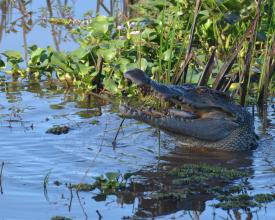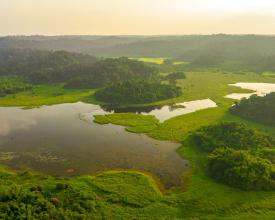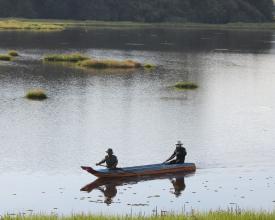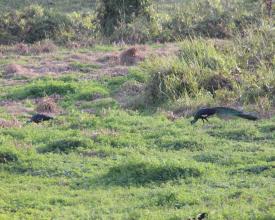
Réussite du ré-ensauvagement des crocodiles siamois dans le site Ramsar de Bau Sau, parc national de Cat Tien
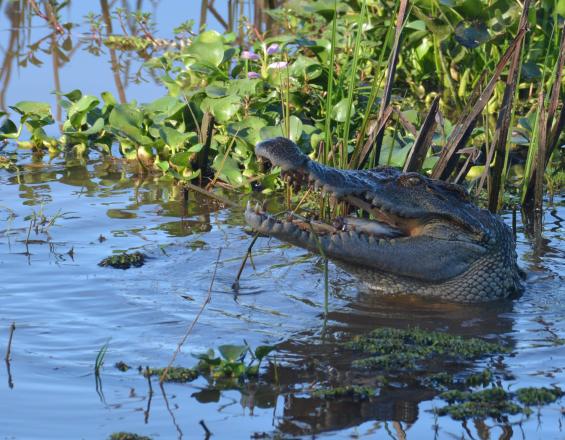
Situé au nord-ouest du parc national de Cat Tien, Bau Sau et les zones humides environnantes abritaient une importante population de crocodiles siamois avant 1980. Cependant, depuis la création du parc en 1992, aucun crocodile n'y a été recensé. En outre, les habitats naturels ont été fortement perturbés par l'empiètement sur les terres arables, l'exploitation des produits forestiers, la chasse et le piégeage des animaux, la pêche illégale, etc.
Les efforts pour rétablir une population de crocodiles dans cette région ont commencé à la fin des années 1990. De 2001 à 2005, 60 premiers crocodiles ont été relâchés dans Bau Sau. En septembre 2005, les premiers bébés crocodiles ont été enregistrés. À ce jour, la population de crocodiles siamois de Bau Sau s'est développée de manière stable et de nouveaux juvéniles ont été enregistrés régulièrement au fil des ans.
Outre les crocodiles siamois, les populations d'autres espèces fréquentant la région de Bau Sau, telles que le gaur, le sambar, la pintade verte et les grands oiseaux d'eau, augmentent également de façon régulière dans le parc.
Contexte
Défis à relever
Le crocodile du Siam était localement éteint dans tout le sud du Vietnam.
De fortes pressions humaines sur les zones protégées entraînant la dégradation de la qualité de l'habitat.
Aucun exemple de réintroduction réussie d'une espèce au Viêt Nam avant le lancement de cet effort, en raison du manque d'habitats sûrs et appropriés.
La réintroduction d'espèces nécessite souvent d'énormes ressources financières et prend beaucoup de temps.
Emplacement
Traiter
Résumé du processus
Depuis la fin des années 1990, l'idée et les efforts visant à mettre en place un programme de rétablissement des populations de crocodiles du Siam dans le parc national de Cat Tien ont été lancés. Pour mettre en œuvre ce programme, de nombreux facteurs nécessaires ont dû être préparés, en particulier la disponibilité de l'habitat et des proies pour que les populations réintroduites puissent s'établir. Avant la création du parc national, les zones humides du parc constituaient une source importante de revenus pour les habitants de la région. Il est donc nécessaire de mener de front deux types d'activités pour i) s'assurer que la réintroduction de la population de l'espèce s'effectue selon des normes et des procédures scientifiques et de conservation conformes aux lignes directrices internationales et ii) s'assurer que les populations relâchées disposent d'un environnement approprié et sûr pour se développer, en évitant le risque d'un conflit potentiel entre l'homme et la faune sauvage.
Blocs de construction
Réintroduction d'une population de crocodiles siamois dans le lac Bau Sau, parc national de Cat Tien
En 1998, les gestionnaires du site et les scientifiques ont discuté de la possibilité de réintroduire une population de crocodiles à Bau Sau. En effet, le lac était situé dans l'aire d'occupation historique de l'espèce et, à cette époque, la qualité de l'habitat avait été améliorée et était prête pour un programme de réintroduction. Des études de faisabilité ont été réalisées. Le parc a également organisé des discussions entre les experts, les gestionnaires et les autorités à tous les niveaux afin d'obtenir un consensus sur le programme.
En 2000, avec le soutien d'experts internationaux, des crocodiles siamois de race pure, dont on pense qu'ils proviennent de la région de Cat Tien, ont été sélectionnés dans une ferme de Ho Chi Minh Ville, afin d'être entraînés à restaurer leurs comportements naturels. De 2001 à 2005, 60 adultes au total ont été relâchés dans Bau Sau. En septembre 2005, les premiers bébés crocodiles ont été enregistrés.
Le suivi récent montre que le nombre d'individus augmente, la zone de distribution s'étend également avec des enregistrements dans certains lacs voisins. En 2019, les données de surveillance ont permis d'enregistrer au moins 286 individus (dont 228 juvéniles). Jusqu'à présent, on peut confirmer que les populations de crocodiles d'eau douce ont été rétablies avec succès dans le parc national de Cat Tien. Le nombre et la structure de la population enregistrée garantissent qu'il s'agit d'une population saine et viable.
Facteurs favorables
- Les habitats naturels des crocodiles dans le parc national de Cat Tien (Bau Sau et les zones humides environnantes) sont bien protégés et restaurés, les populations de proies sont bien maintenues pour faciliter la réintroduction.
- Les sources de races dans les fermes d'élevage de crocodiles répondent aux exigences en termes de génétique et d'épidémiologie.
- Il existe une base scientifique suffisante pour un programme de réintroduction de la population.
- Le soutien des gouvernements et de la communauté internationale a aidé les gestionnaires du parc national à être suffisamment déterminés à rétablir une population de crocodiles du Siam.
Leçon apprise
Le succès du rétablissement d'une population de crocodiles du Siam dans le parc national de Cat Tien est le résultat d'un effort conjoint du Viêt Nam et de la communauté internationale de protection de la nature. C'est une bonne leçon pour les futurs efforts de ré-ensauvagement. La détermination politique locale (gouvernements locaux et responsables de sites) joue un rôle important dans la création des conditions nécessaires au rétablissement de la population.
Les éléments importants pour ce succès comprennent : i) des animaux reproducteurs disponibles pour le ré-ensauvagement, ii) des habitats sûrs avec des sources de proies suffisantes, et iii) une sensibilisation adéquate aux conflits entre animaux et humains pour assurer des comportements compatibles pour la survie à long terme de la population ré-établie.
À ce jour, le programme de rétablissement des crocodiles d'eau douce à Bau Sau a été reconnu comme le premier effort de réintroduction de crocodiles réussi dans le monde, et il peut donc servir d'expérience pour d'autres projets de rétablissement de populations à l'avenir.
Ressources
Atténuation des pressions humaines sur les ressources naturelles du parc
Avant 1990, la zone autour de Bau Sau était soumise à de fortes pressions de la part des communautés locales de la commune de Dak Lua. La population locale pénétrait souvent dans le parc pour récolter du bois, pêcher et chasser des animaux. Les conflits entre les habitants et les gardes forestiers étaient fréquents et graves (avec des morts, et un poste de garde forestier a été incendié en 1990).
Après la création du parc, les gestionnaires se sont concentrés sur l'application de la loi. Un certain nombre de projets de donateurs au cours de cette période ont contribué à améliorer les moyens de subsistance locaux grâce à une agriculture productive et efficace, par exemple l'irrigation, l'augmentation de la culture du riz de deux à trois fois par an, le maïs à haut rendement. Avec l'accord de la population locale, les ménages vivant dans la zone centrale ont été aidés à se réinstaller dans les zones tampons. Des contrats de protection de la forêt ont été signés avec les ménages locaux, des équipes de protection de la forêt ont été mises en place dans les villages autour du parc. Les activités illégales ont été fortement réduites. Les relations avec les communautés locales se sont améliorées, les pressions sur les ressources naturelles ont diminué et la qualité de l'habitat s'est améliorée.
Parallèlement aux mesures proactives de restauration de l'habitat, les populations de faune sauvage se sont rapidement reconstituées. Outre la population de crocodiles siamois qui a été rétablie dans la région de Bau Sau, d'autres populations d'animaux dont la conservation est préoccupante, comme le gaur et la pintade verte, sont bien maintenues.
Facteurs favorables
- Les nouvelles politiques en matière de zones protégées ont permis de résoudre de nombreuses difficultés rencontrées au cours de la période précédente.
- Des plans et des stratégies de conservation appropriés sont en place.
- Les ressources (humaines et financières) fournies par les projets financés au niveau national et international sont suffisantes.
- Participation active des communautés locales aux travaux de conservation.
- Une nouvelle prise de conscience de la conservation de la biodiversité concernant la restauration des espèces sauvages indigènes et menacées.
Leçon apprise
Les résultats obtenus par le parc national de Cat Tien en matière de conservation n'ont pu l'être qu'avec la participation de la communauté. De bons plans stratégiques et des investissements financiers suffisants ont aidé les communautés locales à réorienter leurs activités de subsistance afin de réduire les pressions exercées sur les ressources naturelles, créant ainsi les conditions nécessaires à la restauration et à l'amélioration de la biodiversité du parc.
Impacts
- Rétablissement réussi des populations de crocodiles du Siam, qui ont disparu localement dans le sud du Viêt Nam depuis la fin des années 1980.
- Les populations d'autres espèces dont la conservation est préoccupante, telles que le gaur, le cerf, l'araignée verte, etc. sont également mieux préservées et ont davantage de possibilités de développement.
- La prise de conscience locale est améliorée, la vie des populations locales est stabilisée, ce qui réduit la dépendance vis-à-vis des ressources naturelles du parc.
- Le travail de gestion de la conservation du parc a été amélioré, avec des plans à long et à court terme, des outils et des équipements de soutien, ce qui a permis de réduire la charge de travail du personnel et d'améliorer l'efficacité de la gestion.
- Bau Sau a été restauré pour garantir que les fonctions de l'écosystème de la zone humide soient bien maintenues, notamment le stockage et la régulation de l'eau, la fourniture de bons habitats pour les espèces aquatiques dont les cycles de vie dépendent de l'eau et de l'écosystème de la zone humide du bassin de la rivière Dong Nai.
Bénéficiaires
Espèces utilisant la zone de Bau Sau
Parc national de Cat Tien
Visiteurs du parc
Agences de conservation du Vietnam
Chercheurs
Communautés locales
Histoire
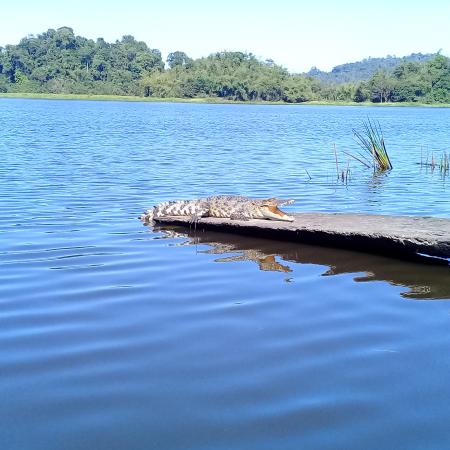
Pham Huu Khanh, responsable des sciences et de la coopération internationale, travaille dans la forêt interdite de Nam Cat Tien depuis 1987. À l'époque, la jeune zone protégée subissait de fortes pressions dues à l'empiètement sur les terres forestières pour l'agriculture, à l'exploitation forestière illégale, à la chasse et au piégeage d'animaux sauvages, à la pêche pratiquée avec des méthodes destructrices, etc. Les zones humides du nord-ouest du parc ont été les plus détruites, là où se rassemblaient autrefois les grands mammifères et les oiseaux pendant la saison sèche, où abondaient les poissons d'eau douce et où vivaient les crocodiles siamois. En outre, l'invasion de Mimosa pigra a également contribué à la dégradation de la qualité des habitats des zones humides, entraînant une diminution du nombre de la plupart des espèces.
Avant 1980, les soldats de la 600e division décrivaient : "les yeux des crocodiles à Bau Sau la nuit sont aussi denses que les étoiles dans le ciel". Cependant, en raison de la perte et de la perturbation de l'habitat, et surtout de la chasse incontrôlée des individus adultes pour la peau et la viande et des juvéniles pour l'élevage, les populations de crocodiles du Siam de Cat Tien et de toute la région du Sud-Est ont été sévèrement réduites et localement éteintes dans les premières années des années 1990.
Depuis 1998, avec le soutien des ministères centraux, des provinces et des organisations internationales, le parc national de Cat Tien a déployé de nombreux efforts pour améliorer la conservation de la biodiversité dans le parc. En particulier, le projet de conservation de Cat Tien dans les zones centrales, financé par le gouvernement néerlandais, et le projet de développement de la zone tampon, cofinancé par le gouvernement néerlandais, le gouvernement vietnamien et la Banque mondiale, ont contribué à renforcer la protection des forêts, la conservation de la biodiversité et à améliorer les moyens de subsistance des populations locales vivant à l'intérieur et aux alentours du parc.
La réintroduction du crocodile du Siam a commencé à la fin des années 1990. De 2001 à 2005, le parc a relâché un total de 60 crocodiles adultes dans Bau Sau. En septembre 2005, les premiers bébés crocodiles ont été enregistrés. En 2019, les données de surveillance ont permis d'enregistrer au moins 286 individus (dont 228 juvéniles). Au cours des 20 dernières années, la population de crocodiles n'a cessé de croître, de nouveaux juvéniles étant régulièrement recensés.
Aujourd'hui, chaque fois qu'il visite Bau Sau, le Dr Khanh se sent toujours très heureux et fier des efforts déployés par de nombreuses générations d'employés du parc national, y compris moi-même, et du soutien du gouvernement et des donateurs, qui ont jusqu'à présent donné des résultats clairs. À l'avenir, des générations de descendants continueront d'admirer le seigneur des marais se prélassant au soleil et attrapant des proies chaque fois qu'ils visiteront le parc national de Cat Tien.
